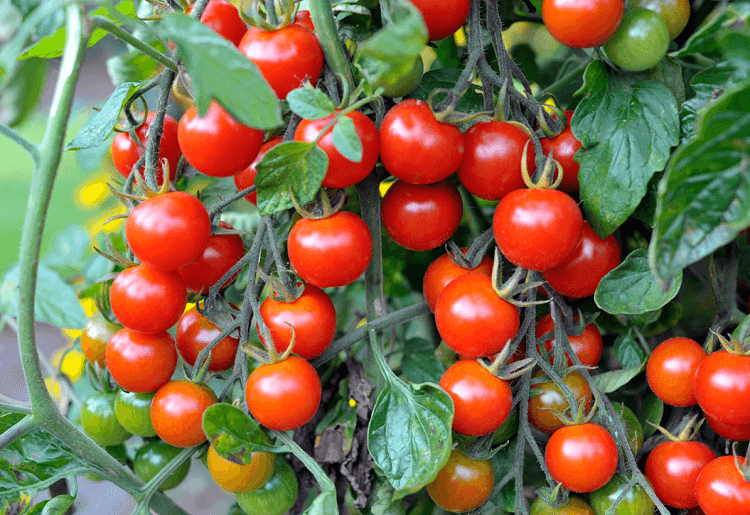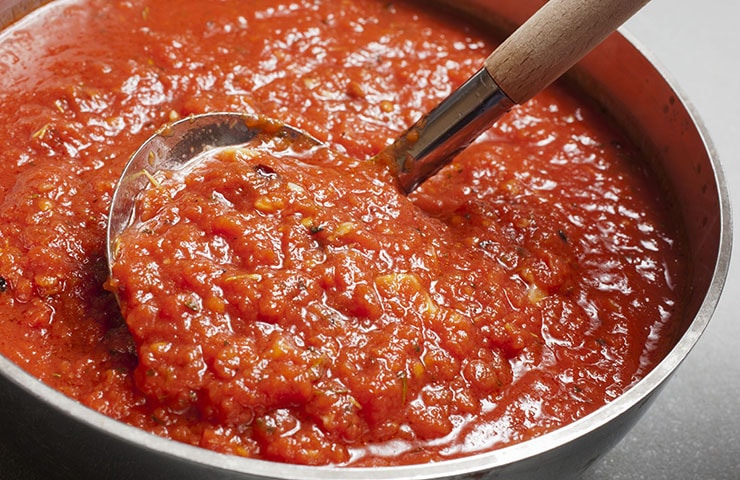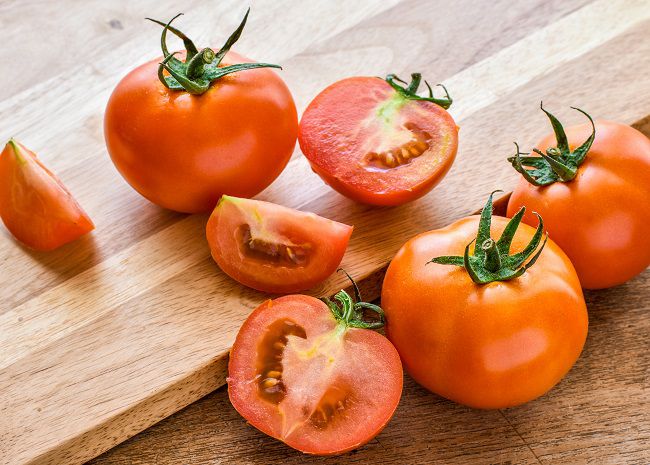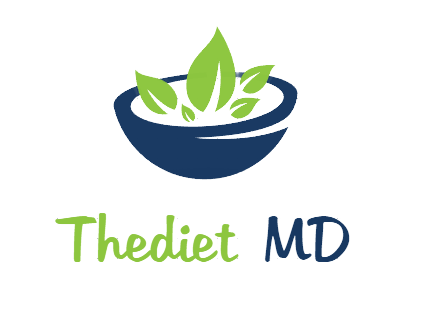Tomato, the fruit of the plant known as tomato ( Lycopersicon esculentum ), is a very popular food all over the world and has among its main benefits the stimulation of weight loss, improvement of eye health and an anti-cancer effect , being considered an important food in the prevention of prostate cancer.
On top of that, the fruit is a very tasty and versatile ingredient, which can be used to prepare juices, soups, tomato sauce, salads and the famous ketchup, and each of the varieties is better suited to a recipe.
Want to know more about it? So continue here because, to help you add the fruit once and for all to your menu, we’ve separated some of the main reasons to eat tomatoes, which are the most common types, as well as some delicious recipes and tips on how to choose and grow them at home!
Table of Contents
Health Benefits of Tomato Consumption
Helps with weight loss
According to nutritionist and director of the Brazilian Society of Food and Nutrition (SBAN), Sueli Longo, tomatoes are “a food of excellent nutritional density, that is, it has a low caloric value and is rich in nutrients such as vitamins, minerals and compounds bioactives” and that makes it great for weight-loss diets .
To get an idea, a 100 gram serving of the fruit has only 17 calories , which shows that it will not increase the caloric intake of the day.
On top of that, tomatoes are rich in water and dietary fiber , which act to increase the feeling of satiety. This means that it helps reduce hunger, so it reduces the amount of food eaten throughout the day, which is also beneficial for weight loss.
Protect the cells
Sueli highlighted that one of the main compounds in tomato is called lycopene, a powerful red colored carotenoid that acts as an antioxidant, preventing the action of free radicals when ingested.
Another type of compound found in tomatoes is ascorbic acid, the popular vitamin C , which is present in good amounts and used by the body.
Thanks to this, adding the fruit to food helps “protects cells against free radicals , when associated with a healthy eating habit”, as the professional explains.
Free radicals, antioxidants, all these names may seem confusing at first, but they’re pretty easy to understand, come on: free radicals are unstable molecules that are produced when a cell starts to degrade, called oxidation.
When this happens they spread and start to stick to other cells, which also start to degrade and the problem keeps getting worse, leaving the body weaker and therefore susceptible to various diseases, and what the antioxidant does is precisely to prevent this process start, is it easy to understand now?
But as the professional warned, for this to be felt it is necessary to adopt healthy eating habits. Even because there is no miracle food and the body needs several components to function in perfect condition.
Prevents cancer
You may have heard that eating tomatoes protects against prostate cancer and know that this is indeed true and is because of the high concentration of lycopene found in it.
This action is mainly derived from its antioxidant potential , which by preventing cell oxidation, reduces the appearance of mutations that initiate cancer.
What happens is that free radicals, in addition to causing cell degradation, can also cause damage to DNA, which are the molecules that hold all the information about how the organism should work. Due to this, the uncontrolled proliferation of cells in a certain region can happen , which start to accumulate and become harmful to the body itself.
Currently there are in vitro studies , carried out using cells in the laboratory, which show the effectiveness of consuming a portion of tomato per day in reducing the risk of developing prostate cancer, as well as breast, lung and esophageal cancer.
A research published in the Revista Interdisciplinar Novafapi indicated that the consumption of these compounds can still bring benefits to people who are undergoing chemotherapy and radiotherapy treatment , as they help to reduce their toxicity to the body.
It is not necessary to eat a kilo of tomatoes daily, right? The data shown in the research indicate that consuming a small portion a day is enough to absorb this and other beneficial substances.
Improves eye health
Do you know the lycopene mentioned by the nutrition professional as an antioxidant? It is also able to protect the health of the eyes and that’s because, after being processed by the body, it is transformed into vitamin A.
Each 100 gram serving of this fruit has an average of 101 micrograms (mcg) of vitamin A in the form of retinol, which would be the pure form, and 50.6 mcg of the nutrient in the form of the equivalent of this retinol, which are the carotenoids.
This vitamin, according to information released by the Brazilian Society of Pediatrics, participates in the formation of cells that make up the retina , conjunctiva and cornea . In addition to joining some types of protein to create light sensitive pigments, which are inside the eye and are activated in low light places.
Therefore, the correct consumption of the nutrient, which is 900 mcg for men and 700 mcg for women, is associated with the prevention of eye problems such as: xerophthalmia (dryness and sclerosis of the eye tissue) and night blindness, which occurs when the body cannot capture information in low light.
The fruit is equally rich in another nutrient important for eye health, vitamin C (or ascorbic acid), with an average of 15.5 mg per serving. This compound is another potent antioxidant and serves to protect not only the region from the harmful effects of sunlight, thus promoting the improvement of local oxygenation.
As a result, its consumption increases oxygenation and consequently local regeneration, thus acting in the prevention of degenerative diseases, such as cataracts .
Reduces cardiovascular problems
Another article, published in Unifacex’s Revista Cultural e Científica, attributed to the lycopene present in tomatoes the ability to protect the body against possible damage caused by free radicals.
Furthermore, this carotenoid inhibits the breakdown of fat , preventing it from “sticking” to tissues and causing even more damage to the body.
A curiosity said by the nutrition professional is that lycopene is found in greater quantities in tomato-based products, such as extract, because it transits better in fatty media, which is good news for those who do not like to consume the fruit crude.
Controls blood pressure
Eating tomatoes is good for blood pressure. That’s right. Regular consumption of the fruit manages to control hypertension, mainly because it is a source of vitamin C, which improves circulation, and potassium, which increases diuresis and the discharge of salts through the urine.
The action of lycopene to prevent the accumulation of fat also works in this sense, as it prevents the formation of fatty plaques in the arteries, a factor that impairs the passage of blood and increases the risk of various cardiovascular problems.
Good for the skin and hair
Finally, adding this food to the menu encourages skin and hair improvement. Firstly, because of the fruit’s antioxidant action, which prevents premature tissue aging.
Secondly, the vitamin present in it stimulates keratinization, making the skin and hair more resistant against daily aggressions. Thirdly, tomato vitamin C favors the production of cells that form the skin and a protein called collagen , which serves to give more firmness and elasticity to the region.
Nutritional table
| 100 Gram serving | Amount per serving |
| Energetic value | 15 Kcal |
| Protein | 1,1 g |
| Cholesterol | – |
| Carbohydrate | 3,1 g |
| Fiber | 1,2 g |
| Calcium | 7 mg |
| Match | 20 mg |
| Ferro | 0,2 mg |
| Sodium | 1 mg |
| Potassium | 222 mg |
| C vitamin | 21,2 mg |
| Magnesium | 11 mg |
* Daily reference values based on a 2000kcal or 8400kj diet. Your daily values can be higher or lower depending on your energy needs. Data taken from TACO, revised and expanded edition.
Tomatoes: main types and what is each one used for?
There are several varieties of tomatoes and each one of them, even if they have similar benefits and nutritional properties, differ in flavor and therefore are more suitable for different ways of preparation.
Below you will see the characteristics of the 4 most cultivated types in Brazil and where to use each of them to enjoy the unique flavor of this fruit. Check it out!
Cherry tomato

Cherry tomatoes are a very small variety , which grow in bunches. This type has a more yellowish color than the others and has a very sweet and mild flavor, even a little watery, which makes it great to be used in lighter and more refreshing dishes.
Due to its delicate appearance, cherry is widely used to decorate dishes and to prepare appetizers , such as canapés and mini vegetable skewers. This variety can also be used to prepare raw salads.
Italian tomato
The Italian tomato is large, with each fruit weighing 100 grams, and it is long, averaging 7 to 10 centimeters in length. Embrapa clarifies that this type has a red color and more pulp .
They are also tastier and have a smaller amount of seeds than other varieties, so they are better suited for preparing sauces and extracts , but they are more fragile and do not last long.
Tomato salad
Another very common type in the Brazilian market is the salad tomato, known as persimmon tomato . This variety is much larger than the others, with each fruit weighing up to half a kilo, which is why it is called a tomato in some places, and has a flat shape at the ends.
The Salad type has a less intense red color than the Italian, almost a pinkish tone, and has a more acidic and mild flavor. Best when used in vinaigrettes or salads.
Tomato Santa Cruz
The Santa Cruz variety, also called Débora tomato , is the most common and cheapest type on the market. The plants are taller and more resistant than the others, which contributes to their popularity among the products.
This type of tomato has a medium size, an average of 150 grams per unit, and has a slightly acidic taste. It is very versatile and can be used both in the preparation of sauces and salads.
Simple and delicious recipes with tomato
Confit tomato
Ingredients
- 500 grams of cherry tomatoes
- 2 cloves of garlic
- ½ teaspoon of black pepper
- ½ cup extra virgin olive oil
- Thyme and salt to taste.
Way of preparing
This recipe is super simple and can be used in appetizers or main courses. To prepare, it is necessary to place all the ingredients in a large pan and put it on a preheated fire at a minimum temperature for at least 1 hour.
During this time the tomatoes will lose water and pick up all the flavor from the spices. Once ready, wait for it to cool and store everything in a sterilized pot in the refrigerator.
Homemade Tomato Sauce

Ingredients
- 2 kg of ripe Italian or Deborah tomatoes
- 2 tablespoons of olive oil
- 1 small onion
- Salt and pepper to taste.
Preparation mode
The homemade sauce is much healthier than the industrialized versions and it’s still super easy to make and can be frozen, so you can prepare a large quantity.
The first step is to remove the skin and seeds from the tomato. This process is simpler than you might think: make an ‘X’ in the tomato’s “butt” and put it to cook for a few minutes in boiling water.
When you notice that the fur has started to loosen, remove from the heat and throw in ice water. Doing this, just pull the skin out whole and very quickly.
The next step is to remove the seeds and blend all the tomatoes in a blender. At this point, you can choose between a chunkier or smoother sauce. While doing this, saute the onion with the oil and when it is browned, add the beaten tomato.
Season with salt and pepper, add fresh herbs and other spices if desired, and cook for at least 1 hour. When the sauce is cold, store it in glass jars or bags and take it to the fridge or freezer.
Tomato juice
Ingredients
- 2 large ripe tomatoes
- 1 liter of water
- 1 lemon juice
- Basil leaves .
Preparation mode
Refreshing and tasty recipe for the summer, which can be drunk straight or used as a base for drinks . To prepare tomato juice at home, you just need to cook or roast the tomatoes until they are half wilted, and wait for them to cool.
The next step is to blend everything in a blender with the lemon juice and basil. No need to strain. If you want a stronger flavor, you can add other herbs or spices.
How to choose and store?

Embrapa recommends choosing tomatoes that have a uniform color, the redder the greater the amount of lycopene, and have a smooth skin and firm texture . The agency also warns of the need to avoid buying unripe fruits, as they do not ripen completely, with stains and wounds.
They can be kept at room temperature, but only for a few days. In the refrigerator they should be kept in plastic bags with a few holes to improve air circulation.
Raw tomatoes should not be kept in the freezer, as only the sauce can be frozen without losing flavor or texture.
Tips on how to grow at home
Best of all, it is possible to grow tomatoes at home and are totally organic , as the plant grows in small spaces and produces a good amount of fruit throughout the year.
For those who want to start organic farming, Embrapa recommends preparing the seedlings before transferring them to the soil. To do this, just take the seeds, which can be taken from the tomato used in everyday life, and plant them in a plastic cup, Styrofoam cup or even in an egg tray with a very soft earth.
Leave it in a well-lit place and water it daily. After 3 weeks, transfer everything to a deep pot, which should have a soil that retains moisture well.
Watering the tomato plant must be done with care, as too much water can cause the plant to overgrow and delay the ripening process of the fruit, but be careful not to allow the soil to dry out. Just with these simple cares the little foot can start bearing fruit 3 to 4 months after planting.
TIP! Tomato branches can break with the weight of the tomatoes, to prevent this, place wooden supports and direct the place where they should grow.
My name is Ellie Lauderdale, MD and I am USA based professional Nutritionist .
I am a Registered Dietitian Nutritionist and board certified specialist in sports dietetics who is trained in integrative medicine. I have worked with hundreds of clients, from those suffering with chronic disease to professional and olympian athletes. My goal is to help optimize you from the inside so that you can feel, perform, and look your best on the outside.


